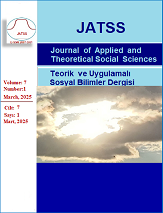The Asymmetric Effects of Climate Change on Health Expenditures in Nigeria: Evidence from Nonlinear ARDL Model
Abstract
Introduction: This study demonstrates the asymmetric impacts of climate change on Nigeria's health expenditures. Climate change has been acknowledged as one of the greatest environmental challenges facing the globe and posing serious threat to human health. The increasing prevalence of climate-sensitive diseases across the world today is largely as a result of environmental degradation. The climate shocks and the associated extreme weather conditions have imposed greater challenges on human health, leading to increase in government and household health expenditures.
Method: A time series analysis was conducted using non-linear autoregressive distributed lag (NARDL) approach in conjunction with Granger causality test over the period spanning from 1990 to 2023. We measure climate change using carbon emission (CO2) and temperature anomalies. To ascertain the possible asymmetric effects of the variables, we decompose carbon emission (CO2) and temperature anomaly into positive and negative partial sums.
Results or Findings: Findings show that positive temperature and CO2 shocks significantly increase costs in both short and long terms, highlighting the urgency for climate action. Conversely, negative CO2 shocks yield long-term health expenditure reductions, showcasing mitigation’s potential. The established unidirectional causality from CO2 emissions to per-capita health spending strengthens the case for targeted emission reduction policies.
Discussion or Conclusion: The finding that a positive shock in temperature and CO2 significantly increases health expenditures underscores the urgent need for climate mitigation strategies.
Metrics
References
Aboubacar, B., & Xu, D. (2017). The impact of health expenditure on the economic growth in sub-Saharan Africa. Theoretical Economics Letters, 7(3), 615-622.
https://doi.org/10.4236/tel.2017.73046
Adenle, A.A., Hossein, A., & Joseph, A. (2015). Global assessment of technological innovation for climate change adaptation and mitigation in developing world, Journal of Environmental Management,161, 261-275.
https://doi.org/10.1016/j.jenvman.2015.05.040
Akpan, U.F., & Chuku, A. (2011, April 27). Economic growth and environmental degredation in Nigeria. Beyond the environmental kuznet curve. MPRA Paper No.31241, https://mpra.ub.uni-muenchen.de/31241/
Ali, M., Awe, E. O., Mohammed, S. S., & Isah, K. O. (2024). Industrialization, FDI inflow and climate change in Africa: A scenario analysis, Chinese Journal of Urban and Environmental Studies, 12(1), 2450003-1 to 2450003-20. https://doi.org/10.1142/S2345748124500039
Anwar, A., Hyder, S., Bennett, R., &Younis, M. (2022). Impact of environmental quality on healthcare expenditures in developing countries. A panel data approach. Healthcare 10(9),1608-1 to 1608-11. https://doi.org/10.3390/healthcare10091608
Apergis, N., Jebli, M.B., &Youssef, S.B. (2018). Does renewable energy consumption and health expenditures decrease carbon dioxide emissions? Evidence from sub-Saharan African countries. Renewable Energy, 127, 1011-1016.
https://doi.org/10.1016/j.renene.2018.05.043
Apergis, N. (2016). Environmental kuznet curves: New evidence on both panel and country-specific C02 emissions. Energy Economics, 54 (3), 263-271. https://doi.org/10.1016/j.eneco.2015.12.007
Azam, M. & Awan, A.M. (2022). Health is wealth: A dynamic SUR approach of examining a link between climate changes and human health expenditures. Social Indicators Research, 163(2), 505–528 https://doi.org/10.1007/s11205-022-02904-x
Barati, M., & Fariditavana, H. (2020). Asymmetric effect of income on the US health expenditure: Evidence from the nonlinear autoregressive distributed lag (ARDL) approach. Empirical Economics, 58, 1979-2008. https://doi.org/10.1007/s00181-018-1604-7
Bhatti, M. A., Ur-Raheem, F., & Zafar, M. A. (2020). Environmental kuznets curve: Empirically examined long run association between globalization, financial development and co2 emission for ASEAN countries. iRASD Journal of Energy & Environment, 1(1), 1-13. https://doi.org/10.52131/jee.2020.0101.0001
Boachie, M. K., Mensah, I. O., Sobiesuo, P., Immurana, M., Iddrisu, A.A., & Kyei-Brobbey, I. (2014). Determinants of public health expenditure in Ghana: A cointegration analysis. Journal of Behavioural Economics, Finance, Entrepreneurship, Accounting and Transport, 2(2), 35-40. https://doi.org/10.12691/jbe-2-2-1
Chaabouni, S., & Saidi, K. (2017). The dynamic links between carbon dioxide (〖CO〗_2) emissions, health spending and GDP growth: A case study for 51 countries. Environmental Research, 158, 137-144. https://doi.org/10.1016/j.envres.2017.05.041
Chen, L., Zhuo, Y., Xu, Z., Xu, X., & Gao, X (2019). Is carbon dioxide (〖CO〗_2) emission an important factor affecting health care expenditure? evidence from China, 2005-2016. International Journal of Environmental Research and Public Health, 16(20),3995. https://doi.org/10.3390/ijerph16203995
Cheng, C., Ren, X., Zang, M., & Wang, Z. (2024). The nexus among C02 emission, health expenditure and economic development in the OECD countries: New insights from a cross-sectional ARDL model: Environmental Science Pollution Research,31,16746-16769 https://doi.org/10.1007/s11356-024-32081-y
Chien, F., Chau, K. Y., & Sadiq, M. (2023). Impact of climate mitigation technology and natural resource management on climate change in China. Resources Policy, 81, 103367. https://doi.org/10.1016/j.resourpol.2023.103367
Eckelman, M. J., Huang, K., Lagasse, R., Senay, E., Dubrow, R., & Sherman, J. D. (2020). Health care pollution and public health damage in the United States: An update: Health Affairs, 39(12), 2071–2079. https://doi.org/10.1377/hlthaff.2020.01247
Erdogan, S., Kirca, M., & Gedikli, A. (2020). Is there a relationship between 〖CO〗_2emissions and health expenditures? Evidence from BRICS-T countries. Business and Economics Research Journal, 11(2), 293–305. https://doi.org/10.20409/berj.2019.231
Erdoğan, S., Yıldırım, D. Ç., & Gedikli, A. (2019). The relationship between 〖CO〗_2 emissions and health indicators: The case of Turkey. Economic Letters, 6(1), 28-39.
FAO, IFAD, UNICEF, WFP and WHO. (2023). The state of food security and nutrition in the world 2023. Urbanization, agrifood systems transformation and healthy diets across the rural–urban continuum. FAO. https://doi.org/10.4060/cc3017en
Frankovic, I. (2017). The impact of climate change on health expenditures. Econ WPS No. 02/2017, Vienna University of Technology Institute of Statistics and Mathematical methods in Economics, Research Group Economics. Retrieved July 12, 2024, from https://hdl.handle.net/10419/149991
Govindaraju, V. C., & Tang, C. F. (2013). The dynamic links between 〖CO〗_2 emissions, economic growth and coal consumption in China and India. Applied Energy, 104, 310-318. https://doi.org/10.1016/j.apenergy.2012.10.042
Pörtner, H.O., Roberts, D.C., Tignor, M., Poloczanska, E.S., Mintenbeck, K., Alegría, A., Craig, M., Langsdorf, S., Löschke, S., Möller, V., Okem, A.& Rama B. (eds.). (2022). Climate change 2022: Impacts, adaptation and vulnerability. Contribution of working group II to the sixth assessment report of the ıntergovernmental panel on climate change, Cambridge University Press. https://doi.org/10.1017/9781009325844 .
Lee, H & Romero J. (eds.). (2023). Summary for policymakers. In: Climate change 2023: synthesis report. contribution of working groups I, II and III to the sixth assessment report of the intergovernmental panel on climate change, IPCC, https://doi.org/10.59327/IPCC/AR6-9789291691647.001
Field, C.B., Barros, V.R., Dokken, D.J., Mach, K.J., Mastrandrea, M.D., Bilir, T.E., Chatterjee, M., Ebi, K.L., Estrada, Y.O., Genova, R.C., Girma, B., Kissel, E.S., Levy, A.N., MacCracken, S., Mastrandrea, P.R., & White L.L. (eds.) (2014). Impacts, adaptation, and vulnerability. Part A: Global and sectoral aspects. Contribution of working group II to the fifth assessment report of the ıntergovernmental panel on climate change. Cambridge University Press.
Khoshnevis, Y.S., & Khanalizadeh, B. (2017). Air pollution, economic growth and health care expenditure. Economic Research-Ekonomskaistraživanja, 30(1), 1181-1190. https://doi.org/10.1080/1331677X.2017.1314823
Kutlu, G., & Örün, E. (2022). The effect of carbon dioxide emission, GDP per capita and urban population on health expenditure in OECD countries: A panel ARDL approach. International Journal of Environmental Health Research. 1–10. https://doi.org/10.1080/09603123.2022.2083088
Lu, Z.N, Chen, H., Hao, Y., Wang, J, Song, X., & Mok, T.M. (2017) The dynamic relationship between environmental pollution, economic development and public health: Evidence from China. Journal of Clean Production, 166, 134-147.
https://doi.org/10.1016/j.jclepro.2017.08.010
Mehfoz, S., Mansha, M., Khan, M., & Musharaf, S. (2023). 〖CO〗_2emissions, health expenditures, and economic growth nexus in Pakistan. IRASD Journal of Energy & Environment, 4(1), 16–29. https://doi.org/10.52131/jee.2023.0401.0032
Melina, D., &Chaido, D. (2023). The relationship between health expenditure, 〖CO〗_2 emissions, and economic growth in G7: Evidence from heterogeneous panel data. Journal of Knowledge Economies,4:1-26. https://doi.org/10.1007/s13132-023-01349-y
Pesaran, M., Shin, Y. & Smith, J. (2001). Bounds testing approaches to the analysis of level relationships. Journal of Applied Econometrics, 16(3), 289–326.
Samah, I. H. A., Abd Rashid, I. M., Husain, W. A. F. W., Ibrahim, S., Hamzah, H., & Amlus, M. H. (2020). The impact of healthcare expenditure and healthcare sector growth on 〖CO〗_2 emission using dynamic panel data system GMM estimation model during COVID 19 crisis, International Journal of Energy Economics and Policy,10(6), 235–241. https://doi.org/10.32479/ijeep.9769
Shin, Y., Yu, B., & Greenwood-Nimmo, M.G. (2014). Modeling asymmetric co integration and dynamic multipliers in a nonlinear ARDL framework. In R.C. Sickles & W.C. Horrace (Eds.) Festschrift in honor of Peter Schmidt Econometric Methods and Applications Springer.
Siami-Namini, S. (2018). Healthcare expenditure, economic growth, and inflation in the G7 countries: A panel co-integration approach. Research Journal of Economics, 2(2), 1–8.
Sileem, H. H. M. (2016). Health expenditure, climate changes and corruption in the MENA region: A granger causality approach. Journal of African Development, 18(2), 61–72.
Socol, A., Iuga, H., Socol, D., & Iuga, I. C. (2023). Does climate change drive up government healthcare costs in the European Union? Frontiers in Environmental Science,11,1-18. https://doi.org/10.3389/fenvs.2023.1286099
Song, Ma-Lin, Wei Z., & Shu-Hong, W. (2013). Infection point of environmental kuznet curve in Mainland China. Energy Policy, 57, 14–20.
Sohail, A., Du, J., & Abbasi, B. N. (2023). Exploring the interrelationship among health status, 〖CO〗_2 emissions, and energy use in the top 20 highest emitting economies: Based on the CS-DL and CS-ARDL approaches, Air Quality, Atmosphere & amp; Health, 16, 1419–1442. https://doi.org/10.1007/s11869-023-01350-z
To, W.M., & Lam, K. H. (2022). Economic growth, energy use, and greenhouse gases emission in Macao SAR, China. Chinese Journal of Urban and Environmental Studies,10(1), 2250002-1 to 2250002-21
Wang, F., Gillani, S., Nazir, R., & Razzaq, A. (2023). Environmental regulations, fiscal decentralization, and health outcomes. Energy & Environment, 35(6), 3038-3064. https://doi.org/10.1177/0958305X231164680
Wang, Z., Asghar, M. M., Zaidi, S. A. H., & Wang, B. (2019). Dynamic linkages among 〖CO〗_2emissions, health expenditures, and economic growth: Empirical evidence from Pakistan. Environmental Science and Pollution Research, 26(15), 15285-15299. https://doi.org/10.1007/s11356-019-04876-x
World Bank Group (n.d.). Climate Change Knowledge Portal. Retrieved December 17, 2024, from https://climateknowledgeportal.worldbank.org
Xu, X., Xu, Z., Chen, L., & Chang, L. (2019). How does industrial waste gas emission affect healthcare expenditure in different regions of China: An application of Bayesian quartile regression. International Journal of Environmental Research and Public Health, 16 (15),2748. https://doi.org/10.3390/ijerph16152748
Zaidi, S., & Saidi, K. (2018). Environmental pollution, health expenditure and economic growth in the sub-Saharan Africa countries: panel ARDL approach. Sustainable Cities and Society, 41, 833-840. https://doi.org/10.1016/j.scs.2018.04.034.
Zeeshan, M., Han, J., Rehman, A., Ullah, I., & Afridi, F. E. A. (2021). Exploring asymmetric nexus between 〖CO〗_2 emissions, environmental pollution, and household health expenditure in China. Risk Management and Healthcare Policy,14, 527–539. https://doi.org/10.2147/RMHP.S281729
Zhang, B., Wang, B., & Wang, Z. (2017). Role of renewable energy and non-renewable energy consumption on EKC: Evidence from Pakistan. Journal of cleaner production, 156, 855-864. https://doi.org/10.1016/j.jclepro.2017.03.203
Zhao, X., Jianmin, L., Wang, J., & Zhou, C. (2005). An empirical test of environmental kuznets’ curve in China. Nankai Economic Studies, 2005(3), 48–54


















